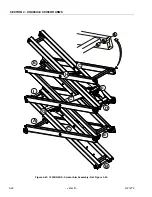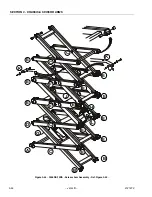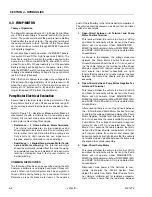
SECTION 4 - HYDRAULICS
4-2
– JLG Lift –
3121273
4.3 PUMP/MOTOR
Theory of Operation
The Power Module (see Section 3.12, Power Control Mod-
ule - ZAPI) is essentially a "low-side" switch for the pump
motor. The positive terminal of the pump is tied to Battery
Positive after the Line Contactor. The negative terminal of
the pump connects to the P Terminal of the Power Mod-
ule, which switches current through MOSFET transistors
to the Battery Negative.
For variable speed pump operation, the MOSFET transis-
tors switch On and Off at high frequencies (16kHz). The
Duty Cycle is varied to control the voltage applied to the
pump motor. When the MOSFET's spend 50% of the
period On and 50% Off, approximately ½ of the available
Battery Voltage will be applied to the pump motor. Simi-
larly, the MOSFET are On continuously (100% Duty Cycle)
to apply all available Battery Voltage to the pump motor
(as in Lift Up at full speed).
When the Control System is energized, the voltage at the
P Terminal will be approxi24V (referenced to -B)
when the pump is static. The P Terminal will be approxi-
mately at +1V (referenced to -B) when the pump is run-
ning at full speed (Lift Up from Ground Mode).
Pump Motor Electrical Evaluation
Several basic electrical tests can be performed on the
Pump Motor. Failure of one of these evaluations is signifi-
cant and may indicate that the device is physically dam-
aged.
Refer to Figure 7-2., Resistance Measurement. Make all
measurements with a voltmeter set to resistance scale
(Ohms). Disconnect main power at the batteries and all
pump motor cables during this analysis.
•
Resistance < 5 Ohms between Motor Terminals.
The internal windings are very low impedance and
should appear to be a short-circuit for an ordinary volt-
meter (other tests can determine if the windings are
truly shorted). High resistance can signal worn
brushes, a faulty commutator, or open windings.
•
Resistance > 1 Mega-Ohms between Motor Termi-
nals and Motor Housing.
The internal windings
should be electrically isolated from the motor housing.
Low resistance may be an indication of a broken motor
terminal, damaged brush, faulty commutator, or
burned winding.
COMMON DIFFICULTIES
The following difficulties can be examined using the JLG
Analyzer, a voltmeter, and simple hand tools. Unless oth-
erwise noted, the Control System shall be energized in
Ground Mode during testing. For a convenient Ground
Reference, place the black meter lead on the negative
post of the left battery in the left-side batter compartment.
The vehicle should be placed on a smooth, firm, and level
surface for all analysis.
1. Open-Circuit bB Terminal and Pump
Motor Positive Terminal
This issue will allow the vehicle to drive, but Lift Up
and Steer Functionality will be lost and the Pump
Motor will not operate. Under DIAGNOSTICS -
PUMP, the JLG Analyzer will show PUMP PWM 100%
and PUMP CUR 0.0A when Lift Up is operated from
Ground Mode.
As shown in the diagram, the voltage measured
between the Pump Motor Positive Terminal and
Ground Reference should be 24V. If it is not, exam-
ine the cable between the terminal and the Power
Module compartment. Inspect crimps for corrosion
and ensure that bolted connections are tight.
Ensure that the cable is not crushed where it passes
between the frame side sheets and the cylinder
assembly.
2. Open-Circuit between Pump Motor Negative Ter-
minal and P Terminal
This issue will allow the vehicle to drive, but Lift Up
and Steer Functionality will be lost and the Pump
Motor will not operate. Under DIAGNOSTICS -
PUMP, the JLG Analyzer will show PUMP PWM 100%
and PUMP CUR 0.0A when Lift Up is operated from
Ground Mode.
After ensuring there is not an Open-Circuit between
the +B Terminal and Pump Motor Positive Terminal,
check that the voltage measured between the Pump
Motor Negative Terminal and Ground Reference is
24V. If not, examine the issues within Open-Circuit
Pump Motor. This voltage should ramp to approxi-
mately 0V when Lift Up is operated from Ground
Mode. If not, examine the cable between the termi-
nal and the Power Module compartment (P Termi-
nal). Inspect crimps for corrosion and ensure that
bolted connections are tight. Ensure that the cable is
not crushed where it passes between the frame side
sheets and the cylinder assembly.
3. Open-Circuit Pump Motor
This issue will allow the vehicle to drive, but Lift Up
and Steer Functionality will be lost and the Pump
Motor will not operate. Under DIAGNOSTICS -
PUMP, the JLG Analyzer will show PUMP PWM 100%
and PUMP CUR 0.0A when Lift Up is operated from
Ground Mode.
Disconnect main power at the batteries to com-
pletely de-energize the Control System. Next,
detach the cable from Pump Motor Positive Termi-
nal. Using a voltmeter set for resistance measure-
ment (Ohms), ensure that the resistance between










































